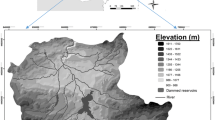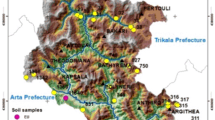Abstract
The objectives of this research are the following: quantitative assessment of erosion-prone areas, assessment of the impacts of climate change on future erosion risks and quantification of erosion risks in relation to landcover classes. The practical value of this study is that it promotes a collaborative planning and decision-making tool for the mitigation of erosion risks and consequences which are inevitable for the Southern Caucasus. The selected study area in the Southern Caucasus is the Ismayilly District. The scientific novelty lies in the fact that it considers the aspects of climate change in the prediction of erosion risks. The Universal Soil Loss Equation was used for the prediction of soil loss rates. Out of 2559 km2, 292 km2 were predicted as critical erosion classes with soil loss rates of more than 10 tons/ha/year. Precipitation impacts calculated by means of theHadGEM2-AOclimate change model to erosion processes also showed an increase in soil loss rates. The quantification of predicted erosion related to landcover revealed a significant variation of critical erosion classes within bare lands (5–10 ton/ha/year to 6.21 km2, 10–20 ton/ha/year to 11.90 km2, 20–50 ton/ha/year to 28.24 km2, 50–100 ton/ha/year to 15.44 km2, 100–200 ton/ha/year to 0.75 km2). The quantification of erosion rates related to landcover classes showed their highest spatial distribution variability within barelands (62.55 km2 out of total 71 km2) and grasslands (339.44 km2 out of total 895 km2). Significant areas of stressed vegetation with low NDVI values (0.1–0.2) were observed to be 259.51 km2 within croplands affected by intensive agricultural activities which reduced soil productivity over years.







Similar content being viewed by others
References
Arnoldus HMJ (1980) An approximation of the rainfall factor in the universal soil loss equation. In: de Boodt M, Gabriels D (eds) Assessment of erosion. John Wiley & Sons, Chichester, pp 127–132
Bayramov ER (2013) Quantitative assessment of vegetation renaturation and soil degradation and their control by climate and ground factors along rights-of-way of petroleum/gas pipelines, Azerbaijan. Ph.D. Dissertation. Dresden University of Technology, Dresden, Germany
Bayramov E, Buchroithner M (2014) Monitoring of vegetation and soil erosion prediction along pipelines. LAP LAMBERT Academic Publishing, Riga, p 148
Bayramov E, Buchroithner M, &McGurty E (2012a) Prediction reliability, quantitative differences and spatial variations of erosion models for long-range petroleum and gas infrastructure. Georisk Assess Manag Risk Eng Syst Geohazards 6(4):252–272. (https://doi.org/10.1080/17499518.2012.743834)
Bayramov E, Buchroithner M, &McGurty E (2012b) Quantitative assessment of vegetation cover and soil degradation factors within terrain units for planning, monitoring and assessment of renaturation along oil and gas pipelines. Geocarto Int 27(7):535–555. (https://doi.org/10.1080/10106049.2011.648662)
Bayramov E, Buchroithner M, Bayramov R (2016) Multi-temporal assessment of ground cover restoration and soil erosion risks along petroleum & gas pipelines in Azerbaijan using GIS and remote sensing. Environ Earth Sci 75:256. (https://doi.org/10.1007/s12665-015-5044-9)
Bewket W, Teferi E (2009) Assessment of soil erosion hazard and prioritization for treatment at the watershed level: Case study in the Chemoga watershed, Blue Nile basin, Ethiopia. Land Degrad Dev 20:609–622
Chowdary VM, Yatindranath KS, Adiga S (2004) Modelling of nonpoint source pollution in a watershed using remote sensing and GIS. Ind J Remote Sens 32(1):59–73
Dabral PP, Baithuri N, Pandey A (2008) Soil erosion assessment of a hilly catchment of North Eastern India using USLE, GIS and remote sensing. Water Resour Manag 22:1783–1798
Dalu T, Tambara EM, Clegg B, Chari LD, Nhiwatiwa T (2013) Modeling sedimentation rates of Malilangwe reservoir in the south-eastern lowveld of Zimbabwe. Appl Water Sci 3(1):133–144
Favis-Mortlock DT, Boardman J (1995) Nonlinear responses of soil erosion to climate change: a modelling study on the UK South Downs. Catena 25:365–387
Favis-Mortlock DT, Guerra AJT (1999) The implications of general circulation model estimates of rainfall for future erosion: a case study from Brazil. Catena 37:329–354
Fick SE, Hijmans RJ (2017) Worldclim 2: new 1-km spatial resolution climate surfaces for global land areas. Int J Climatol 37:4302–4315
Gajbhiye S, Mishra SK, Pandey A (2014) Relationship between SCSCN and sediment yield. Appl Water Sci 4(4):363–370
Gitas IZ, Douros K, Minakou C, Silleos GN, Karydas CG (2009) Multi-temporal soil erosion risk assessment in N. Chalkidiki using a modified USLE raster model. EarseL eProc 8(1):40–52
Hijmans RJ, Cameron SE, Parra JL, Jones PG, Jarvis A (2005) Very high resolution interpolated climate surfaces for global land areas. Int J Climatol 25:1965–1978
Ismail J, Ravichandran S (2008) RUSLE2 model application for soil erosion assessment using remote sensing and GIS. Water Resour Manag 22:83–102
Jain SK, Kumar S, Varghese J (2001) Estimation of soil erosion for a Himalayan watershed using GIS technique. Water Resour Manag 15:41–54
Karger DN, Conrad O, Böhner J, Kawohl T, Kreft H, Soria-Auza RW, Zimmermann NE, Linder HP, Kessler M (2017) Climatologies at high resolution for the earth’s land surface areas. Sci Data 4:170122
Khare D, Mondal A, Kundu S, Mishra PK (2017) Climate change impact on soil erosion in the Mandakini River Basin, North India. Appl Water Sci. https://doi.org/10.1007/s13201-016-0419-y
Koutalakis P, Vlachopoulou A, Zaimes GN, Ioannou K, Iakovoglou V (2014) Assessing soil erosion risk using SWAT and GIS for Thassos Island, Greece. In: Proceedings of the 10th international conference of the Hellenic geographical society, Thessaloniki, Greece
Lal R (1990) Soil erosion in the tropics: principles and management. McGraw-Hill, New York
López-Vicente M, Navas A (2010) Routing runoff and soil particles in a distributed model with GIS: Implications for soil protection in mountain agricultural landscapes. Land Degrad Dev 21:100–109
Mannaerts CM, Gabriels D (2000) Rainfall erosivity in Cape Verde. Soil Tillage Res 55:207–212
Michael A, Schmidt J, Enke W, Deutschlander T, Maltiz G (2005) Impact of expected increase in precipitation intensities on soil loss results of comparative model simulations. Catena 61:155–164
Mondal A, Khare D, Kundu S (2016) Change in rainfall erosivity in the past and future due to climate change in the central part of India. Int Soil Water Conserv Res 4:186–194
Montgomery DR (2007) Soil erosion and agriculture sustainability. Proc Natl Acad Sci USA 104(33):13268–13272
Morgan RPC (2005) Soil erosion and conservation, 3rd edn. Blackwell Science Ltd., Oxford, p 304
Morgan RPC, &Duzant JH (2008) Modified MMF (Morgan–Morgan–Finney) model for evaluating effects of crops and vegetation cover on soil erosion. Earth Surf Proc Land 32:90–106
Morgan RPC, Quinton JN, Smith RE, Govers G, Poesen JWA, Auerswald K, Chisci G, Torri D, Styzcen ME (1998) The European Soil Erosion Model (EUROSEM): a dynamic approach for predicting sediment transport from fields and small catchments. Earth Surf Proc Land 23:527–544
Mukundan R et al (2013) Suspended sediment source areas and futureclimate impact on soil erosion and sediment yield in a New York City water supply watershed. USA Geomorphol 183:110–119
Mullan D, Favis-Mortlock DT, Fealy R (2012) Addressing key limitations associated with modelling soil erosion under the impacts of future climate change. Agric For Meteorol 156:18–30
Mutua BM, Klik A, Loiskandl W (2006) Modelling soil erosion and sediment yield at a catchment scale: the case of Masinga catchment, Kenya. Land Degrad Dev 17:557–570
Neal MR, Nearing MA, Vining RC, Southworth J, Pfeifer RA (2005) Climate change impacts on soil erosion in Midwest United States with changes in crop management. Catena 61:165–184
Nearing MA, Foster GR, Lane LJ, Finckner SC (1989) A process-based soil erosion model for USDA-Water Erosion Prediction Project technology. Trans Am Soc Agric Eng 32:1587–1593
Nearing MA, Wei H, Stone JJ, Pierson FB, Spaeth KE, Weltz MA, Flanagan DC (2011) A rangeland hydrology and erosion model. Trans Am Soc Agric Biol Eng 54:1–8
Pandey A, Chowdary VM, Mal BC (2007) Identification of criticalprone areas in the small agricultural watersheds using USLE, GIS and remote sensing. Water Resour Manag 21:729–746
Plangoen P, Babel MS, Clemente RS, Shrestha S, Tripathi NK (2013) Simulating the impact of future land use and climate change on soil erosion and deposition in the Mae Nam Nan sub-catchment. Thail Sustain 5:3244–3274
Renard KG, Foster GA, Weesies GA, McCool DK, Yoder DC (1997) Predicting soil erosion by water: a guide to conservation planning with the revised universal soil loss equation (RUSLE). In: Renard KG (ed) Agriculture handbook. U.S, Department of Agriculture, Agricultural Research Service, Washington, DC, USA, vol 703, p 404
Routschek A, Schmidt J, Kreienkamp F (2014) Impact of climate change on soil erosion—a high-resolution projection on catchment scale until 2100 in Saxony/Germany. Catena 121:99–109. https://doi.org/10.1016/j.catena.2014.04.019
Sukhanovski YP, Ollesch G, Khan KY, Meissner R (2001) A new index for rainfall erosivity on a physical basis. J Plant Nutr Soil Sci 165:51–57
Van der knijff JM, Jones RJA, Montanarella L (2000) Soil erosion risk assessment in Europe. Office for Official Publications of the European Communities, Luxembourg, p 34
Wischmeier WH, Smith DD (1978) Predicting rainfall erosion losses— A guide to conservation planning. In: USDA—agriculture handbook. Agricultural research service, U.S. Government Printing Office, Washington, DC, vol 537, p 58
Author information
Authors and Affiliations
Corresponding author
Additional information
Publisher’s Note
Springer Nature remains neutral with regard to jurisdictional claims in published maps and institutional affiliations.
Rights and permissions
About this article
Cite this article
Bayramov, E., Schlager, P., Kada, M. et al. Quantitative assessment of climate change impacts onto predicted erosion risks and their spatial distribution within the landcover classes of the Southern Caucasus using GIS and remote sensing. Model. Earth Syst. Environ. 5, 659–667 (2019). https://doi.org/10.1007/s40808-018-0557-3
Received:
Accepted:
Published:
Issue Date:
DOI: https://doi.org/10.1007/s40808-018-0557-3




